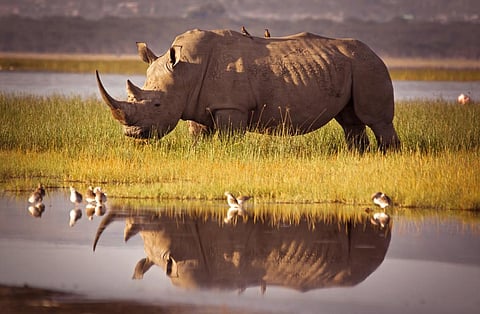‘Insatiable demand from the East, greed & lack of political will is enabling poaching across Africa’
Rhino numbers continue to decline in South Africa. Photo: iStock
Dave “Wild Vet” Cooper has been a wildlife veterinarian in Africa for the past 40 years. One of the three founding directors of non-profit African Wildlife Vets, he has seen it all, from the most gruesome cases of poaching, performing over 600 post-mortem examinations of rhinos and attending to countless other crime scenes across the continent.
In September 2022, Cooper retired from his position as Chief Veterinarian of Ezemvelo KwaZulu-Natal (KZN) Wildlife, a governmental organization responsible for maintaining wildlife conservation in South Africa. But he still plans to offer his services to conservation in the continent, where the need is evergrowing for his services.
Cyril Zenda interviewed Cooper for Down To Earth (DTE) about African wildlife conservation. Edited excerpts:
CZ: How has it been like to work with some of Africa’s most endangered animals, including the legendary Big Five — lion, leopard, rhino, elephant and African buffalo?
DC: Of all the “big five”, black rhinos are still my favourite! However, one must not forget the little guys, which can be just as challenging, like tiny elephant shrews, Tonga squirrels, mongoose, red and blue duiker, etc.
CZ: Why do you think poaching cases are not going down, despite all the efforts and resources being committed to anti-poaching activities? For example, rhino population in South Africa continues to decline.
DC: The insatiable demand from the East, greed, impoverished communities around conservation areas and lack of political will to counter the threat of poaching. If a country like Rwanda and Eswatini can do it, why not South Africa?
CZ: Can the poaching trend realistically be stopped?
DC: With political will, an incorruptible judicial and formal law enforcement system, the introduction of compulsory integrity testing, better use of technology, bigger budgets and better intelligence, anything is possible.
If the private sector has thus far been largely successful, then so can those formally protected areas. Resources being committed to this effort are worth it only if they are supported like this.
CZ: In Africa, poverty levels are very high and there is no community sense of ownership of wildlife resources. Locals wallowing in abject poverty see the resources as belonging to (and therefore benefitting) others, not themselves. How would you respond to the suggestion these reasons make poaching very hard to stop in the continent?
DC: These are very valid points and should be urgently addressed.
CZ: How would you respond to suggestions that it is challenging to manage poaching because there are a lot of insiders, like rangers, vets, police officers, government officials, etc, within these poaching syndicates?
DC: Very true and hence the need for regular compulsory integrity testing.
CZ: Do you think climate change poses any serious threat to wildlife? If so, how?
DC: There have been noticeable changes in the habitat, which has already affected things like species composition. Wildlife, in general, is fairly resilient and adaptable.
Extreme weather such as flooding and drought will, however, have severe effects, especially in smaller fenced-off areas where wildlife does not have the option to migrate.
CZ: About two years ago, mass die-offs of elephants in Botswana and Zimbabwe brought forward other dangers to wildlife than poaching. Is enough being done to control diseases in wildlife in Africa and is there sufficient expertise for this task?
DC: The problem is perhaps more related to overpopulation than disease, which can be a natural form of population control. Anthrax is a good example. Although we certainly have the expertise, the problem is generally a lack of resources, as is the case with the recent outbreak of foot and mouth disease (FMD).
The threat to wildlife is more indirect through the regulation of movement since indigenous diseases such as FMD have little effect on wildlife. Movement control and the erection of disease control fences have had a significant impact, with Botswana being a good example.
CZ: You consider translocation as a critical conservation management tool. How many of these exercises have you been a part of?
DC: Translocations of larger numbers need vets throughout the process of capture, translocation and release. These are generally for those where the species have been transported under anaesthesia (predators such as lion, leopard and wild dog) or the larger herbivores, in particular, rhinos.
Rhino relocation operations have been the most memorable: 28 black rhinos to Zimbabwe in 1998, 89 white rhinos to Botswana, and recently 16 black rhinos to Eswatini, 17 to Malawi, 10 to Tanzania and last year, 30 white rhinos to Rwanda.
Airlifting the 200th black rhino out of an inaccessible area and the 50 gaurs translocated in India to reverse a local extinction were also highlights.
Participating in the WWF-funded black rhino expansion programme responsible for translocating many founder populations from KwaZulu Natal province in South Africa and the Eastern Cape province has been very special!
CZ: Anything else that you may like to share with our readers?
DC: Formal conservation organisations are currently hopelessly under-resourced and will likely worsen as time passes.
Personally, I feel that formal conservation in southern Africa is doomed and sometime in the future areas such as Hluhluwe iMfolozi Park are likely to be taken over by non-profits as has happened in many other African Parks.
For the last five years, I have relied on donor funding to remain operational, so public support is essential in order to manage these areas effectively.


